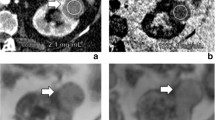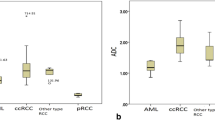Abstract
Background
Discrimination of low grade (grade 1–2) renal tumors from high grade (grade 3–4) ones carries crucial importance in terms of the management of these patients and also in the decision-making of appropriate treatment strategies. Our aim was to investigate whether contrast-enhanced multidetector computed tomography (MDCT) and T2 weighted fast spin echo (FSE) magnetic resonance imaging (MRI) could play a specific role in the discrimination of low grade versus high grade tumors in clear cell renal cell carcinoma (ccRCC) and papillary renal cell carcinoma (pRCC) patients.
Methods
In this study, we retrospectively evaluated 66 RCC patients based on histopathologic findings who had underwent either partial or total nephrectomies. Our cohort consisted of 52 ccRCC and 14 pRCC patients, of whom 50 were male (%76) and 16 were female (%24). Among the 52 ccRCC patients, 18 had both cortico-medullary phase contrast-enhanced CT and MRI, 15 had only cortico-medullary phase CT and 19 had only MRI examination. In the pRCC group, 8 patients had both cortico-medullary phase contrast-enhanced CT and MRI, 3 had only cortico-medullary phase CT and 3 had only MRI. We both calculated mean tumor attenuation values on cortico-medullary phase MDCT images as HU (hounsfield unit) and also tumor mean signal intensity values on FSE T2 weighted MR images, using both region of interest and whole lesion measurements including normal renal cortex. The obtained values were compared with the grading results of the ccRCC and pRCC tumors according to the WHO/International Society of Urological Pathology grading system.
Results
A significant positive correlation was found between the mean attenuation values of both tumor subtypes on cortico-medullary phase contrast-enhanced CT and their grades (p < 0.001). High grade tumors exhibited higher mean attenuation values (74.3 ± 22.3 HU) than the low grade tumors (55.2 ± 23.7 HU) in both subtypes. However, a statistically significant correlation was not found between the mean signal intensity values of the two tumor subtypes on FSE T2 weighted MR images and their grades (p > 0.05). Low grade tumors had a mean signal intensity value of 408.9 ± 44.6, while high grade tumors showed a value of 382.1 ± 44.2. The analysis of the ccRCC group patients, yielded a statistically significant correlation between the mean signal intensity values on T2 weighted images and tumor grading (p < 0.001). Low grade (grade 1–2) ccRCC patients exhibited higher mean signal intensity values (475.7 ± 51.3), as compared to those of high grade (grade 3–4) (418.5 ± 45.7) tumors. On the other hand, analysis of the pRCC group patients revealed that there was a significant correlation between the mean attenuation values of tumors on cortico-medullary phase contrast-enhanced CT and their grades (p < 0.001). High grade papillary subtype tumors (54.2 ± 25.2) showed higher mean attenuation values than the low grade (35.5 ± 18.8) ones.
Conclusions
Contrast-enhanced MDCT and T2 weighted FSE MRI can play a considerable role in the discrimination of low grade versus high grade tumors of both subtype RCC patients. Thus, these non-invasive evaluation techniques may have positive impact on the determination of the management and treatment strategies of these patients.



Similar content being viewed by others
References
Capitanio U, Montorsi F (2015) Renal cancer. Lancet 387:894–906
Patard JJ, Leray E, Rioux-Leclercq N, Cindolo L, Ficarra V, Zisman A et al (2005) Prognostic value of histologic subtypes in renal cell carcinoma : a multicenter experience. J Clin Oncol 175:481–482
Tsili AC, Argyropoulou MI (2015) Advances of multidetector computed tomography in the characterization and staging of renal cell carcinoma. World J Radiol 7:110–127
Rioux-Leclercq N, Karakiewicz PI, Trinh QD, Ficarra V, Cindolo L, de la Taille A et al (2007) Pognostic ability of simplified nuclear grading of renal cell carcinoma. Cancer 109:868–874
Cui E, Li Z, Ma C, Li Q, Lei Y, Lan Y et al (2020) Predicting the ISUP grade of clear cell renal cell carcinoma with multiparametric MR and multiphase CT radiomics. Eur Radiol 30:2912–2921
Lane BR, Samlaski MK, Herts BR, Zhou M, Novick AC, Campbell SC (2008) Renal mass biopsy: a renaissanse? J Urol 179:20–27
Suzuki K, Mizuno R, Mikami S, Tanaka N, Kanao K, Kikuchi E et al (2012) Prognostic significance of high nuclear grade in patients with pathologic T1a renal cell carcinoma. J Clin Oncol 42:831–835
Palmowski M, Schifferdecker I, Zwick S, Macher-Goeppinger S, Laue H, HaferKamp A et al (2010) Tumor perfusion assessed by dynamic contrast-enhanced MRI correlates to the grading of renal cell carcinoma : initial results. Eur J Radiol 74:176–180
Harris CR, Whitson JM, Meng MV (2012) Under-grading of < 4 cm renal masses on renal biopsy. BJU Int 110:794–797
Feng Z, Shen O, Li Y, Hu Z (2019) CT texture analysis: a potential tool for predicting the Fuhrman grade of clear-cell renal carcinoma. Cancer Imaging 19:6
Birnbaum BA, Bosniak MA, Krinsky GA, Cheng D, Waisman J, Ambrosino MM (1994) Renal cell carcinoma: correlation of CT findings with nuclear morphologic grading in 100 tumors. Abdom Imaging 19:262–266
Pichler M, Hutterer GC, Chromecki TF, Jesche J, Kampelkettner K, Rehak P et al (2012) Histologic tumor necrosis is an independent prognostic indicator for clear cell and papillary renal cell carcinoma. Am J Clin Pathol 137:283
Huber J, Winkler A, Jakobi H, Bruckner T, Roth W, Hallscheidt P et al (2014) Preoperative decision making for renal cell carcinoma: cystic morphology in cross-sectional imaging might predict lower malignant potential. Urol Oncol 32(37):e1-6
Beddy P, Genega EM, Ngo L, Hindman N, Wei J, Bullock A et al (2014) Tumor necrosis on magnetic resonance imaging correlates with aggressive histology and disease progression in clear cell renal cell carcinoma. Clin Genitourin Cancer 12:55–62
Turun S, Banghua L, Zheng S, Wei Q (2012) Is tumor size a reliable predictor of histopathological characteristics of renal cell carcinoma? Urol Ann 4:24–28
Oh S, Sung DJ, Yang KS, Sim KC, Han NY, Park BJ et al (2017) Correlation of CT imaging features and tumor size with Fuhrman grade of clear cell renal cell carcinoma. Acta Radiol 58:376–384
Sun X, Liu L, Xu K, Li W, Huo Z, Liu H et al (2019) Prediction of ISUP grading of clear cell renal cell carcinoma using support vector machine model based on CT images. Med (Baltimore) 98:e15022
Whittier WL (2012) Complications of the percutaneous kidney biopsy. Adv Chronic Kidney Dis 19:179–187
Kwon YK, Kim BH, Park CH, Kim CI, Chang HS (2009) Effectiveness of computed tomography for predicting the nuclear grade of renal cell carcinoma. Korean J Urol 50:942–946
Villalobos-Gollas M, Aguilar-Davidov B, Gomez-AlvaradoCulebro-Garcia MO, Rojas-Garcia P, Ibarra-Fombona R et al (2012) Pathological implications of areas of lower enhancement on contrast-enhanced computed tomography in renal-cell carcinoma: additional information for selecting candidates for survelliance protocols. Int Urol Nephrol 44:1369–1374
Zhu HY, Wang X, Zhang J, Chen YH, Kong W, Huang YR (2014) Low enhancement on multiphase contrast-enhanced CT images : an independent predictor of the presence of high tumor grade of clear cell renal cell carcinoma. AJR Am J of Roentgenol 203:295–300
Coy H, Young JR, Douek ML, Pantuck A, Brown MS, Sayre J et al (2019) Association of qualitative and quantitative imaging features on multiphasic multidetector CT with tumor grade in clear cell renal cell carcinoma. Abdom Radiol 44:180–189
Sandrasegaran K, Sundaram CP, Ramaswamy R, Akisik FM, Rydberg MP, Lin C et al (2010) Usefulness of diffusion-weighted imaging in the evaluation of renal masses. AJR Am J of Roentgenol 194:438–445
Doshi AM, Huang WC, Donin NM, Chandarana H (2015) MRI features of renal cell carcinoma that predict favorable clinico-pathologic outcomes. AJR Am J of Roentgenol 204:798–803
Vargas HA, Delaney HG, Delappe EM, Wang Y, Zheng J, Moskowitz CS et al (2013) Multiphasic contrast-enhanced MRI : single-slice versus volumetric quantification of tumor enhancement for the assessment of renal clear-cell carcinoma fuhrman grade. J Magn Reson Imaging 37:1160–1167
Author information
Authors and Affiliations
Corresponding author
Ethics declarations
Conflict of interest
There is no potential conflict of interest.
Ethical approval
Hospital Ethics comittee approval was not needed due to retrospective nature of the study.
Informed consent
Informed consents were obtained from the patients before examinations.
Additional information
Publisher's Note
Springer Nature remains neutral with regard to jurisdictional claims in published maps and institutional affiliations.
Rights and permissions
About this article
Cite this article
Halefoglu, A.M., Ozagari, A.A. Tumor grade estımatıon of clear cell and papıllary renal cell carcınomas usıng contrast-enhanced MDCT and FSE T2 weıghted MR ımagıng: radıology-pathology correlatıon. Radiol med 126, 1139–1148 (2021). https://doi.org/10.1007/s11547-021-01350-y
Received:
Accepted:
Published:
Issue Date:
DOI: https://doi.org/10.1007/s11547-021-01350-y




